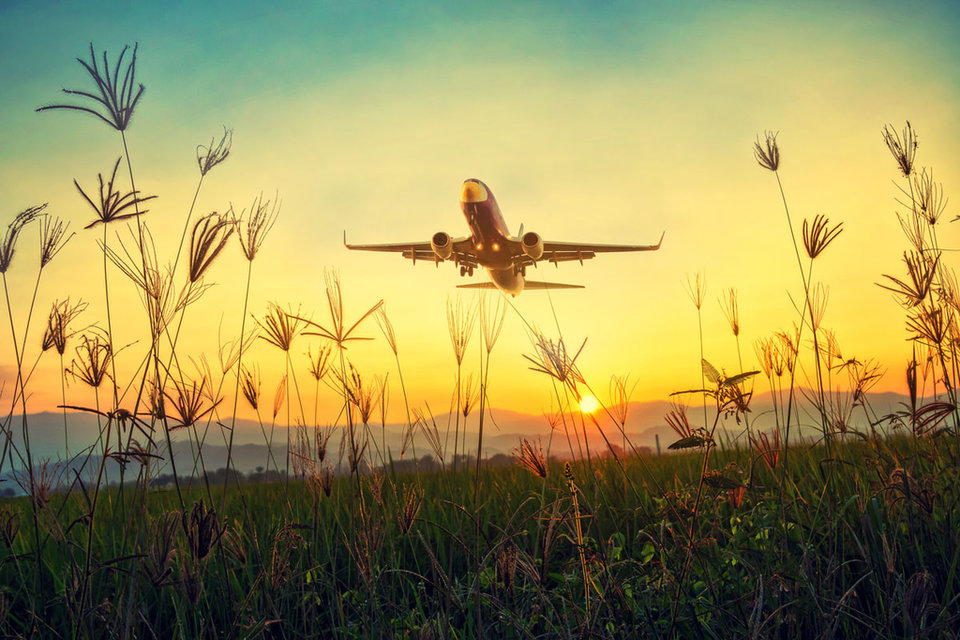AIRPORT OPERATIONS
Reasons to be cheerful: what’s next for airports in 2021?
It’s no secret that 2020 has been a dark time for many airports, but are there reasons to be cheerful ahead of next year? Here, Airport Industry Review writers Joe Baker, Adele Berti, Ilaria Grasso Macola and Chris Lo gleam silver linings from a difficult year and ask: what might the future hold?
Joe Baker: New technologies could help airports rise like a phoenix next year

Aviation may have screeched to halt in 2020, but the drive for creating a more seamless airport experience must continue. I’m excited about going back to airports, not just for the prospect of domestic and foreign travel but also to glimpse where new technologies are making the passenger journey faster, safer and more enjoyable.
Biometric and facial recognition tech will surely be major beneficiaries of the Covid-19 pandemic. This October, Emirates launched its integrated biometric path at Dubai International Airport. From check-in to boarding gates at the airport, a mixture of facial and iris recognition technologies allow passengers for the airline to drop their bags, complete immigration procedures, and board flights simply by walking through the terminal. The airport is following in the footsteps of Singapore Changi in the pursuit of paperless transit, and it won’t be the last.
The pressing issue of the day is curbing the transmission of coronavirus in busy airport spaces, but facial recognition technologies have lasting appeal. Removing the faff from passing through airports frees up staff to deal with more pressing issues and allows passengers to move more swiftly into retail and food and beverage areas, which have been hard hit by the Covid-19 travel restrictions.
Technology is set to further enhance all aspects of the customer experience, from measuring passenger throughput to receiving customer feedback. However, I think the real balance-tipper will be improved connectivity. In our November issue, we discussed how the rollout of 5G mobile connectivity will have consequences for the entire airport chain, across baggage handling, passenger processing and even aircraft communications.

Better connectivity will form the cornerstone of better airport operations – for example, allowing more effective monitoring of vehicles at airports to speed up turnarounds. What’s more, faster, more stable Wi-Fi will have a dramatic impact on passengers in terminals, particularly for those who need to stay online. With 2020 seeing an expected but still remarkable dent in business travel, airports need to make themselves more appealing to workaholics glued to their tablet screens.
It's true that some projects are still largely being undertaken at an experimental level. It’s unlikely the humanoid robots seen at Tokyo Haneda Airport will become the norm for the industry in 2021, but we’ve observed their potential for remedial tasks from their performance as disinfectant distributors (see San Antonio International Airport, which recently deployed a robot that trundles around terminals targeting viruses and bacteria with bursts of ultraviolet light).
Will new technologies help airports rise out of the ashes in 2021? Passenger footfall remains low at many aviation hubs, with some even putting ongoing construction and development projects on hold until a comeback is on the cards. But make no mistake: as they get back on their feet, airports will continue to seek out smart technologies that improve their operations and make terminals a much more pleasant place to be.
Adele Berti: Unprecedented times equal unprecedented opportunity

While this is undoubtedly a difficult time for the sector, it is also the perfect chance to test out new concepts, fuels and decarbonisation models without the chaos of pre-Covid traffic. “Historically low traffic levels offer us a chance to do things that might have been impossible or extremely difficult under normal circumstances and we’re considering a number of short term measures that could improve the environmental efficiency of our operation,” Ian Jopson, head of environmental and community affairs at UK air traffic manager NATS recently wrote.
Covid-19 has given travellers a fear of flying that has inevitably impacted revenues and forced stakeholders to seek financial support from governments. The thinking goes that making climate change a priority will help make aviation more appealing to passengers, as well as attract private and public investment in a difficult economic environment.
Countries such as France, Austria and the Netherlands have shown eagerness to reward these efforts, having imposed climate criteria in their airline bailout packages. Similar initiatives will be paramount across the world if the sector wants to bounce back.

Encouragingly, the sector is on track to achieve this goal, supported by research, new technologies and hundreds of decarbonisation projects currently taking place around the world. As Transport & Environment aviation manager Jo Dardenne told AIR earlier this year: “The impact of Covid-19 on aviation emissions in 2020 and the rate at which the industry is likely to bounce back create an opportunity to make 2019 the “peak” year for aviation emissions in Europe, especially as we will see the growing deployment of technology and increasing societal shifts from air travel.”
The list of examples is endless, but now more than ever it is worth mentioning some ground-breaking projects.
Airbus is currently working to prove the feasibility of wake energy retrieval in aviation, which could involve pairing aircraft in order to decrease CO2 emissions by 10%. In the UK, a coalition of government ministers, businesses and environmental groups have launched the Jet Zero Council, aiming to make zero-carbon transatlantic flights a reality over the next decade.
Across the ocean, the North American Aerospace Industries Corporation is preparing to open a $100m aircraft recycling facility that will dismantle and upcycle as much as 95% of an aircraft’s components. Also in the US, San Diego airport is trialling initiatives designed to reduce on-site waste, while Japanese airline All Nippon Airways will soon start using Neste’s sustainable aviation fuel.
These successes show the sector’s determination to play its part in tackling climate change and one reason to be optimistic ahead of 2021.
Ilaria Grasso Macola: ACI’s Health Accreditation is providing reassurances to anxious frequent fliers (like me)

As a result of the Covid-19 pandemic, people are less likely to fly. According to a survey conducted by public opinion and data company YouGov in July, 64% of British people said they did not feel comfortable taking a plane, whilst 70% added that they weren’t planning to travel internationally over the next six months.
With a yearly average of around 20 flights taken and an Alitalia’s MilleMiglia membership card, I consider myself a frequent flyer, and travelling by plane has always been one of my favourite activities. Ever since the pandemic began, though, I grew increasingly anxious at the idea of taking a plane, not only because the thought of sitting so close to another person triggered my anxiety but also because I was never confident in the standards that were actually implemented at airports.
But the good news is that organisations have been looking for ways to convince passengers that flying is still safe. The Airport Council International’s (ACI) airport health accreditation is a prime example. The certification provides airports with a year-long assessment of their health and safety measures, showing that they are aligned with recommendations from the International Civil Aviation Organisation’s Council Aviation Recovery Task Force as well as the industry’s best practices.

To be certified, airports need to abide by a series of standards, including deep disinfection and cleaning, the installation of hand sanitisers and the use of protective screens in areas where staff members are actively in touch with customers. This is music to the ears of anxious travellers.
This allows airports to demonstrate to passengers, staff and regulators that they’re putting health and safety at the centre of their recovery plans.
“While the Covid-19 pandemic’s effects have halted the airport industry at global level, airports are vital cogs in the aviation ecosystem, and our airport health accreditation programme will help to restore passenger confidence in air travel,” commented ACI World director general Luis Felipe de Oliveira in July.
The initiative is being adopted by an increasing number of airports. As of November 2020, 425 airports had applied and 113 had received their accreditation. These include Istanbul, Hong Kong and Luton.
Over the next few months, this programme will prove crucial in showing that flying is safe, providing the certainty that if an airport has the accreditation, its standards are the highest.
As for myself, the accreditation is also helping me choose where to fly more wisely. The last time I booked a flight I made sure that the airports I was travelling to and from had the accreditation and from now on, this will make all the difference for me and anxious travellers around the world.
Chris Lo: Berlin Brandenburg opens, ending a decade-long debacle

On 31 October, the new Berlin Brandenburg Airport Willy Brandt (BER) – named after the late German Chancellor and Nobel Peace Prize recipient – finally opened its doors to the public.
The opening event centred around the landings of two aircraft operated by easyJet and Lufthansa (described as “our most important partners even in these difficult times” by airport operator FBB’s chief executive Engelbert Lütke-Daldrup), and was attended by Minister-President of the State of Brandenburg Dietmar Woidke, Berlin’s governing mayor Michael Müller and German Federal Minister of Transport and Digital Infrastructure Andreas Scheuer, among others.
As German politicians and airport executives celebrated the airport’s official launch, the prevailing sentiment – for those directly involved as well as the people of Berlin – may have been one of profound relief that the project had at last reached a decisive milestone after a beleaguered construction phase that had seen delays of nearly a decade and costs that ballooned from around €2bn to nearly €7bn.
“The people here in the German capital region had to wait a long time for this day,” said Lütke-Daldrup during the opening ceremony.

Credit: Ekaterina Zershchikova-Flughafen Berlin Brandenburg GmbH
A long wait might be an understatement for a project that single-handedly put a dent in Germany’s reputation for efficiency. The new airport had been in the planning since the 1990s, with construction commencing in 2006 and an opening date set for 2011. But the blown deadlines and false starts were seemingly endless during the airport’s convoluted development saga, which included the bankruptcies of both the airport’s construction planning company and one of its main intended airline customers (Air Berlin), as well as corruption and bribery allegations, management changes and ruinously expensive deficiencies in the project’s fire safety and smoke exhaust systems.
Even amid the added challenges presented by a global pandemic, BER managed to stick to its final launch date of October 2020. With the opening of the airport, Berlin’s Schönefeld Airport has been incorporated into the new air hub as Terminal 5, on the north side of the area’s two parallel runways. Terminal 1 and 2 are located between these runways, which can be operated independently, although Terminal 2 currently remains closed until demand picks back up amid Covid-19.
BER’s launch on 8 November also enabled the long-delayed closure of Berlin Tegel Airport, a Cold War-era facility that, while holding a soft spot in many Berliners’ hearts for its striking hexagonal design and proximity to the city centre, was not suited to the needs (or aircraft sizes) of 21st-century aviation.
BER will now settle into its role as Berlin’s sole and flagship airport, with transport options including a dedicated motorway connection and a rail link directly to a six-track train station beneath Terminal 1 – FBB expects that two-thirds of passengers will reach the airport by train. As demand begins to recover and Terminal 2 opens, BER will have an annual capacity of 40 million passengers. FBB and the German Government are aiming to leverage this new infrastructure to dramatically increase long-haul flights and connecting services at the airport, creating a true aviation hub in the vein of Frankfurt and Munich.
“Today, the world is looking at BER, an airport that has been a source of great emotion for all of us in recent years,” said Scheuer in October. “I hope that it will now quickly win the hearts of the people, just as Tegel had a firm place in the hearts of Berliners for decades. As Minister of Transport, it is my aim to see BER become an international hub.”